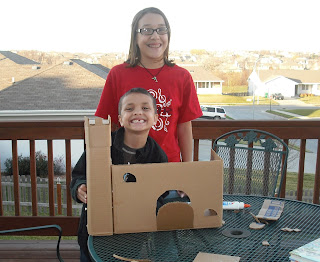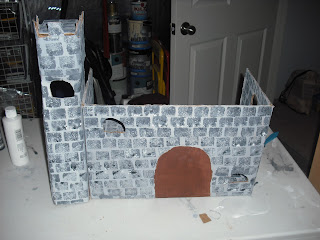Helping your kids make their own prints or stamps can be fun and practical. When finished, the stamps can be used over and over again to make personalized cards, gift bags, or even art prints to frame and hang on the wall (or give away as gifts).
There are a couple of different methods you can use to create the prints. One involves using sharp carving tools and a special stamp-making block that you can purchase at a local arts and craft store. The other method, which is safe enough even for the pre-schoolers, involves using a pencil and a piece of styrofoam from the grocery store (like the kind you find veggies packed on in the produce aisle). No matter which method you choose, you will end up with a darling kid-crafted work of art that you can duplicate over and over.
First, the tot (and budget) friendly method:
You will need paper, pencils, sheets of styrofoam trimmed to about 4x6 inches, tape, poster paint or
block printing ink, and a paint brush or
ink roller.
1. Have your child draw a simple design on a 4x6 section of paper. Don't let him get too detailed because small details will not show up well in the finished product.
2. When satisfied with the design, help your child to transfer the image to the styrofoam by taping the drawing to the foam and drawing over it. Be sure to press into the foam as you draw.
3. Remove the paper from the foam and inspect it to make sure the design is transferred properly. If the design is not pressed sufficiently into the foam, trace over it again, making sure to press into the foam, leaving deep grooves.
4. With a paintbrush or roller, apply the poster paint or ink to the entire surface of the newly made "stamp." Be careful not to let the paint fill the grooves you just made (this is easier to avoid when using a roller rather than a paint brush).
*Note: If you use a roller and ink, simply put the desired amount of ink onto a paper plate and roll the roller over it until it covers the roller surface. Then use the roller to roll the ink onto the stamp.
5. Get stamping! Press the image onto a clean sheet of paper, being sure to put even pressure of the entire surface.
If it didn't turn out exactly like you expected, tweak it a bit. If the design doesn't show up quite right, it may be that the grooves weren't deep enough. If the ink doesn't transfer completely, it may be that you didn't use quite enough ink. But remember: small imperfections in the finished print make each one that much more unique, so don't be too picky!
Clean-up is easy. Simply rinse the stamp and roller in cool water and let them dry!
Now, the traditional method:
You will need to purchase a set or two of linoleum block cutters. They can be ordered
online or found at a local arts and crafts store.
You will also need some speedy-cut carving blocks, also available for purchase
online or at a local arts and crafts store. These come in a variety of sizes, are soft and pliable and very easy to cut into.
Other supplies you will need are paper, pencils, ball point pen, carbon paper (or alternative -- see instructions), roller, and block printing ink.
1. The first thing your artist needs to do is draw a design, using a section of paper the same size as the block to be used. The design should be fairly simple, but there is more room for detail in this method than when using styrofoam. Keep in mind that the more detailed the design is, the trickier it will be to carve into the block.

2. Transfer the image using carbon paper. Alternatively, you can use a soft lead pencil (such as a 6B art pencil) to shade in the back side of the paper with the design on it. Place the paper shaded side down onto the carving block, then trace using a ball point pen.
*Note: Another option is to draw the design directly onto the block itself.
3. It's a good idea to trace over the design on the block with ball paint pen. This will help ensure that the image is sharp and clear and won't get rubbed off.
4. Time to carve! Your artist will carve out whatever she wants to remain white (or the color of the paper) in the finished print. Be careful not to carve out something that is meant to be printed!
*Note on safety: Always supervise your child when he or she is using sharp tools. When carving, be sure that the sharp edge of the cutting tool is facing away from you at all times. Use a non-skid surface to keep the block from slipping, such as a piece of a non-slip rug pad or similar product.
5. Using the method described above, use the roller to spread ink onto the surface of the block. Be sure to cover the entire surface evenly.
6. Use gentle, even pressure to print the design onto a sheet of paper. Inspect the print to be sure that you didn't forget to carve out any part of the design. Then you can repeat the process to make framable art, note cards, or custom gift bags!
Clean up by rinsing the block and roller in cool water.
Questions or comments? We'd love to hear from you. In the mean time, have fun printing!


















































